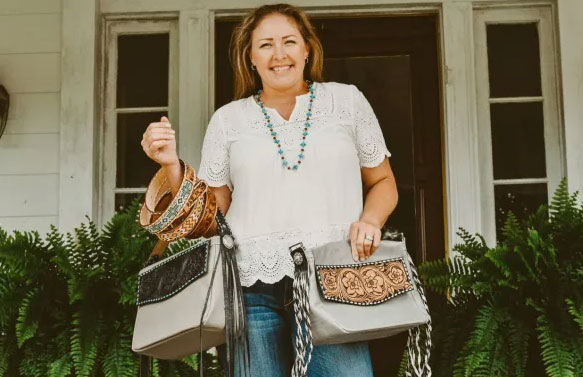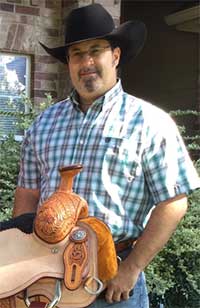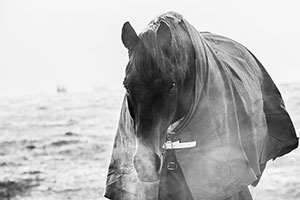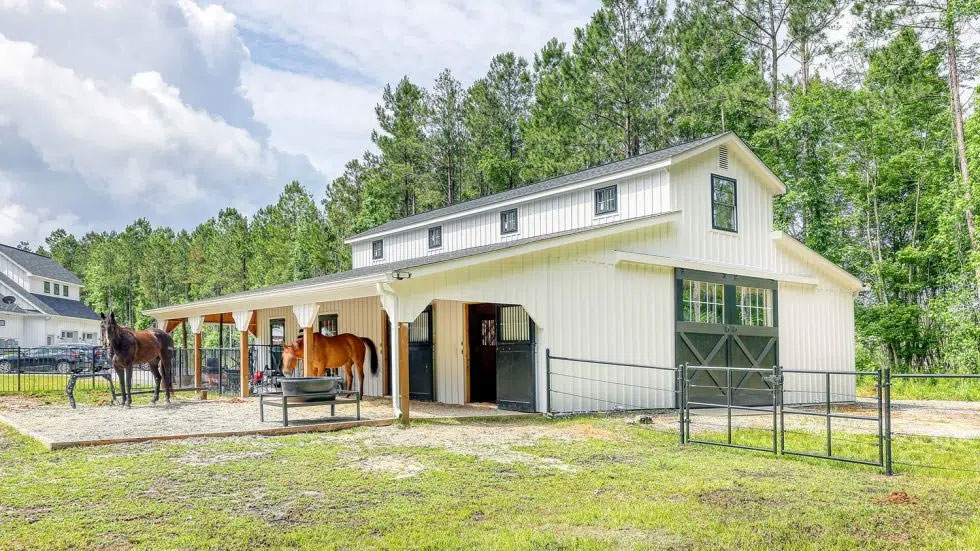Tack & Farm
Our Tack & Farm section features an Apparel section to find both practical and fashionable riding attire. If you ride English & Western or Race, many sources are available in the Tack section.
Building a barn? Need an architect for your equine dream home? Find one in Barns & Stalls.
Have a hungry horse? Of course you do! Find a place to buy your feed and tuck your horse in at night in the Bedding & Feed section. Looking for a place to keep your horse? You can find it in the Horse Boarding section. Keep your horse happy and beautiful with resources in our Grooming section.
Traveling? Find a Shipping company or Horse Sitting service if your horse is staying home!
Running and maintaining a farm or stable is a continuous effort, and to help find products or tools you need, please see our Equipment, Fencing and Management Tools sections.
Seeking Services? Find financial and tax expertise in our Accounting section. Companies who will help protect your investment are found in the Insurance section. For those who want legal advice about purchasing, liability, and other issues, please look at the Equine Law section to find an expert. Build and promote your business with teams from Marketing / Videography / Web Design.
Do we need to add more? Please use the useful feedback link and let us know!

by Liisa Andreassen
When the colts she was riding started breaking her stuff, Dee Dee McGraw took matters into her own hands. She knew that making her own repairs would save her money, but what she didn’t know was that it would eventually lead to a full-time gig. She started out doing patch and repair work, and her mom quickly recognized how much she enjoyed it and offered to buy her a whole hide. That was just the beginning. Not too long after, Dee Dee stopped into Tandy Leather in Montgomery, Alabama, to buy some fancier tools and reference books and it just snowballed from there.
She became a frequent flier at Tandy and, as luck would have it, met a manager named Chance.
“Chance really moved me into carving and the art end of the craft,” she says. “Until then, I didn’t know that I should rub my edges or go over my bevel marks with modeling spoons. He really helped me to take my game to the next level.”
In 2008, Dee Dee decided it was time to quit her job. She was traveling a lot and wanted to be closer to home. It took a while for the business, DND Leather, to turn into full-time work, so she continued to give some riding lessons to supplement the income.
Today, her favorite thing to do is tooling. Drawing? Not so much. She admits that drawing was taking much more time than it should until Britt Nantz, a well-known tooling artist, came along to give her some tips.
“He put me over the tipping point,” she says. “And once I learned more about how to draw, the production got so much faster. It used to take me anywhere from four to 16 hours to just draw out a new belt design. It should take about 30 minutes. You just can’t make money doing that. Now, it takes me about five hours to complete the whole belt job – start to finish (with no dye or super fancy tooling).”
Read more: DND Leather – Where Beauty and Function Come Together

By Gene Fowler
Christmas morning, 1986, in Wilcox, Arizona. Eight-year-old Adam Tanner tears into his presents. His face lights up at the first glimpse of one particular gift emerging from the Santa-Claus-and-snow-scene wrapping. A Tandy Leathercraft Starter Kit.
“My uncle, who had made a little money doing leathercraft part-time while in college, helped me with the seven stamps and the belt, wallet, key fob and other projects in the kit,” says Adam, who today builds saddles at Tanner Custom Leather, his home-based workshop in Weatherford, Texas. “He made it look easy. I wasn’t that good at first, of course, but it was so much fun. Then I started riding my bike down to the local saddle shop to watch ’em work. So, I’ve always been drawn to it.”
Though his primary interest today is saddlemaking – Adam is currently building in 106th saddle and has 20 custom saddle orders in the pipeline – he also finds time to make one-of-a-kind belts, wallets, tack, chaps, holsters, briefcases, and rope cans. “My business slogan used to be Everything but Boots and Shoes,” he jokes.
Growing up, Adam enjoyed an additional creative outlet, playing jazz saxophone. “I was playing in the high school jazz band when I was in seventh grade,” he recalls. “And it also put me through college with a scholarship.” Like many leather artists who explore other artforms, he sees parallels in two forms of self-expression. “They’re both therapeutic. They both can help you get on an even keel if you’re feeling a little down and out.”
In 2002, his leatherwork became part-time business as he worked full time in advertising sales. Primary self-taught, Adam says he built his first saddle with the help of the humongous (708 pages!) Stohlman Encyclopedia of Saddlemaking. “It’s a great resource if you can understand what he’s saying. But if you don’t have enough knowledge going in, it can be difficult. I had to keep pulling everything apart and redoing it, so I used enough leather that i could have built two saddles.”
Around 2003, Adam got the rodeo bug and with a lick of irony for an aspiring saddlemaker, he chose bareback bronc riding as a primary event. He was involved with the Grand Canyon Pro Rodeo Association up until 2014 and with the PRCA until 2008. “I did it more for the fun, though, than the money,” he says. “I was already married with kids, so I didn’t want to be gone from home so much. I guess you could say my leather hobby paid for my rodeoin’.”
Still, it’s clear he was pretty devoted to the sport. “I broke my back in early 2008, and six months later I broke it again. Then after breaking my leg in motocross in 2009, I decided to sit out for two years.” But when he came back, he came back in style winning the GCPRA Bareback Championship in 2011.

The decision of whether to rug a horse plagues a significant number of horse owners, particularly when the weather becomes colder. Many of them would most likely unpack turnout and stable rugs for their horses at the same time that they take out their fleeces and jumpers to keep themselves warm. However, horses do not experience the same discomfort from cold temperatures as people, so would they require turnout rugs?
Why Horses Need Turnout Rugs
<p;> A horse's thermo-neutral zone is significantly larger than a human's, so the freezing winter cold does not affect it as much as it does us. Horses also generate heat through thermoregulation and are very good at retaining that heat. On the other hand, when the temperature drops, the horse's hair stands on end, creating a barrier that traps heat. If you have a clipped horse, you might require an additional gram or two of a rug to act as a warmth shield.
A turnout rug is a great investment as it will not only keep the horse warm but will also keep the horse clean, preventing it from getting wet and losing heat. There are varying degrees of defense and warmth that a rug provides, and the Kentucky turnout rug is ideal for all kinds of weather. The vast selection of turnout rugs is not only fashionable but also practical, and they can help keep your horse comfortable no matter what the weather is like.
Factors to Consider When Buying a Turnout Rug for Your Horse
The ideal turnout rug will prevent the horse from getting cold and wet in the field. In addition, it will offer a layer of protection against the elements. The following is a list of considerations to make before making a purchase of a turnout rug for your horse.
1. Weight
You can choose light, medium, or heavy weights for your turnout rug, depending on your needs. Lightweight coats are adequate for the spring and fall seasons, while medium and heavyweight coats are more appropriate for the cold season.

by Nikki Alvin-Smith
When it comes to building a new barn the quality and complexity of plans run the gamut from elaborate architect drawn designs to renderings drawn by hand by a keen horse owner or neophyte construction personage.
Making sense of barn plans is essential if the outcome of the build is to match the intended design. The level of detail the drawing plans will entail will likely be a combination of what is minimally required by the local building code office for permits and what the construction company intends to complete. Bear in mind some towns have no requirement for permitting at all particularly for agricultural buildings.
Outside of the level of intricacy the building plans must define for the permit process, if the property owner understands the factors that should always be included in building plans this can go a long way to ensuring that the final build matches their envisioned horse barn and avoid disappointments in materials used and the quality of the construction. Even in areas where no plans are required, having plans at hand to define the parameters of construction is a good idea.
Drawn from the two perspectives of the construction company and the building code requirements the plans can be submitted via various methods. Electronic submissions of CAD or similar software developed plans is quick and easy to do where it is accepted by the local authorities, and hard print copies can easily be provided for use on the job site and for owner approval. While not as high grade, plans that are hand drawn with pen and ruler can also work if the barn is a simple design such as a run-in shed or two stall shed row.
Some building codes require that the building plans be certified and stamped by a qualified engineer. This all important ‘stamp’ indicates that the structural integrity of the design has been reviewed by a professional and approved as safe and meeting certain codes for wind and snow loads and that the build itself is adopting commonly accepted building practices and materials.
However, not any stamp or certification will do. It is important that the stamp provided is issued in accordance with the regional requirements of your State and exact location.
For example: a set of plans for a center aisle barn to be sited in hurricane prone Florida will not require the same parameters in the build as the identical building sited on a snow laden New Hampshire hilltop.
The certification of plans by a licensed engineer offers the property owner important assurance that the barn will be properly built to provide safe use and to be durable.
Companies that construct horse barns on a national level are aware of regional requirements and changes in Federal and State building codes that may affect the plans and will follow directives with accuracy that minimizes delays in the permit issuance process. Often these larger companies employ their own drafting professionals who can adjust their myriad of in-house barn designs to accommodate any need. Whether that need be a specification that a particular building inspector requires or a custom upgrade that the barn purchaser wants to make. Where it is allowed by the State laws, such companies can liaise directly with the town building department through initial submission to full approval and permit issuance for a build on behalf of the property owner.
Read more: Horizon Structures Presents Series: Making Sense of Barn Building Plans
- Horizon Structures Presents Series: Is Your Horse Barn Wearing the Right Hat?
- The Not-So-Great Indoors
- Seeking a New Spot for Your Horse? Need and Overnight Horse Motel? Look No Further, We've Got This!
- Horse Boarding - Checklist!
- The Cowboy Leathercrafter
- What Kind of Saddle Pad Is Best for Your Horse?
- Celebrating 100 Years of Exceptional Harness Making
- Three-Generations of Legendary Artistry
- Epic Leather Work on a Greek Island
- Frecker’s Saddlery: A Family Affair
































